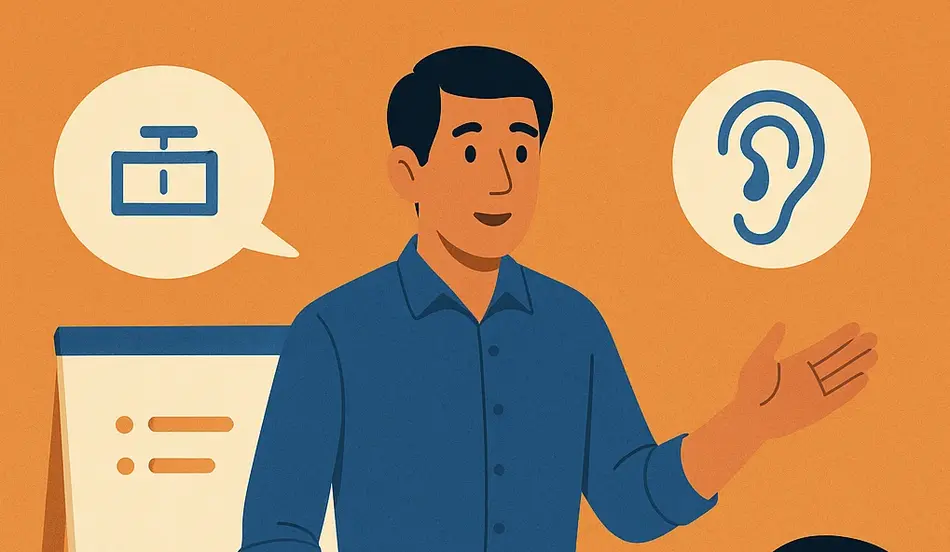In today’s fast-paced professional environment, spontaneous speaking situations arise constantly—from unexpected questions during presentations to impromptu introductions at networking events. Research from Chapman University reveals that public speaking ranks among Americans’ top five fears, alongside terrorist attacks and identity theft. Yet while many professionals prepare extensively for planned presentations, few develop strategies for these unplanned speaking moments that can significantly impact career advancement.
According to communication experts, spontaneous speaking situations actually occur more frequently than planned presentations in professional settings. These moments—giving impromptu feedback, responding during Q&A sessions, or being asked to introduce someone at a dinner—often catch us unprepared, triggering anxiety and reducing our effectiveness precisely when making a strong impression matters most.
This comprehensive guide explores evidence-based techniques for mastering spontaneous speaking situations, helping you transform anxiety-inducing moments into opportunities to showcase your expertise and leadership abilities.
Table of Contents
The Hidden Challenge of Impromptu Communication
Why Spontaneous Speaking Causes Anxiety
The anxiety triggered by impromptu speaking stems from a fundamental psychological challenge: simultaneously determining what to say and how to say it under time pressure. Unlike planned presentations where you’ve organized your thoughts in advance, spontaneous speaking requires real-time processing that can overwhelm even experienced communicators.
As communication expert Matt Abrahams explains, “Most nervous speakers distance themselves physically and linguistically” when put on the spot. This distancing—both in body language and word choice—creates barriers between you and your audience precisely when connection matters most.
Managing Speaking Anxiety: The Foundation of Spontaneous Communication
Acknowledge Your Anxiety
When you begin feeling the physical symptoms of speaking anxiety—perhaps a racing heart, shaky voice, or perspiration—research on mindful attention suggests that simply acknowledging these feelings can prevent them from spiraling out of control.
Instead of thinking, “I’m nervous, this is going to go badly,” try greeting your anxiety with: “This is me feeling nervous. I’m about to do something consequential.” This simple reframing prevents the anxiety spiral that can overwhelm your cognitive resources.
Reframe Speaking as Conversation, Not Performance
Many professionals approach speaking situations as performances where they must “get it right.” This mindset creates unnecessary pressure that triggers anxiety and reduces authenticity.
A more effective approach is reframing speaking situations as conversations rather than performances. Unlike theatrical performances where mistakes derail the experience, conversations naturally include pauses, clarifications, and adjustments—all perfectly acceptable in professional communication.
To shift from a performance to a conversational mindset:
- Use questions to create dialogue: Begin with questions that engage your audience, making the interaction two-way rather than one-way
- Employ conversational language: Replace formal, distancing language (“One must consider…”) with inclusive, conversational phrasing (“We should think about…”)
- Structure your thoughts as questions: When organizing your response, frame key points as questions you’ll answer rather than statements you’ll make
Become Present-Oriented
Research by Stanford psychologist Philip Zimbardo demonstrates that anxiety about speaking often stems from excessive focus on future consequences rather than present engagement. By bringing yourself into the present moment, you reduce anxiety about potential outcomes.

Effective techniques for becoming present-oriented include:
- Physical movement: A brief walk before speaking activates your body and focuses your mind on the present
- Focused listening to music: Selecting specific songs that help you concentrate and center yourself
- Tongue twisters: Saying challenging phrases that require complete concentration while also warming up your voice
Learn more about managing communication anxiety from the National Institute of Mental Health
The Four-Step Process for Effective Spontaneous Speaking
Step 1: Get Out of Your Own Way
The first barrier to effective spontaneous speaking is often our own perfectionism. The desire to provide the “right” answer or make the perfect impression creates mental friction that prevents authentic communication.
Communication research shows that speakers who focus less on perfection and more on genuine engagement consistently receive higher audience ratings. This counterintuitive finding reveals an important truth: audiences connect more with authentic speakers than with those striving for flawless delivery.
To get out of your own way:
- Recognize your brain’s tendency to “stockpile”: Notice when you’re mentally preparing and rehearsing responses instead of truly listening
- Practice responding without planning: Train yourself to trust your ability to formulate thoughts in the moment
- Embrace the improvisation principle of “Dare to be dull”: Release the pressure to be brilliant, allowing your natural expertise to emerge
Step 2: See Speaking as an Opportunity, Not a Threat
How you perceive spontaneous speaking situations fundamentally shapes your response. When viewed as threats or challenges, these moments trigger defensive communication patterns that limit your effectiveness.
Research in cognitive psychology demonstrates that reframing situations as opportunities rather than threats significantly impacts performance outcomes. This mental shift allows you to approach spontaneous speaking with curiosity and engagement rather than fear and defensiveness.
To reframe spontaneous speaking as an opportunity:
- Focus on the value you can provide: Consider how your response might clarify, inform, or assist others
- Embrace the “Yes, and” mindset: Instead of mentally resisting unexpected questions or situations, accept them as starting points for meaningful exchange
- View questions as invitations: See questions not as challenges to your authority but as expressions of interest in your perspective
Explore research on cognitive reframing from the American Psychological Association
Step 3: Slow Down and Listen
Effective spontaneous speaking depends on truly understanding what’s being asked or expected of you. Many professionals respond to the question they think they heard rather than what was actually asked, creating disconnection and missed opportunities.
Communication research shows that speakers who take time to fully process questions before responding are perceived as more thoughtful, confident, and authoritative than those who rush to answer.
To improve your listening before spontaneous speaking:
- Pause before responding: Allow yourself a moment to process what you’ve heard
- Focus completely on the speaker: Resist the urge to begin formulating your response while others are still speaking
- Consider using paraphrasing: Restate the question or prompt to ensure understanding and buy yourself thinking time
Step 4: Use Structured Response Formats
The final and perhaps most powerful technique for spontaneous speaking is employing consistent structural frameworks for your responses. Research shows that structured information is processed approximately 40% more efficiently than unstructured information, benefiting both you as the speaker and your audience.
Two particularly effective structures for spontaneous speaking include:
- Problem-Solution-Benefit Structure: This three-part framework provides a clear path for addressing challenges or opportunities:
- What-So What-Now What Structure: This versatile framework helps organize informational responses:
Read more about structured communication techniques from Harvard Business Review
Putting It All Together: Practical Applications for Professional Settings
Responding to Unexpected Questions
Whether during a presentation Q&A, a job interview, or a meeting with executives, unexpected questions can trigger anxiety. Apply the four-step process by:
- Getting out of your own way: Release the need to have the perfect answer
- Seeing the question as an opportunity: View it as a chance to clarify or showcase your knowledge
- Listening carefully: Ensure you understand what’s being asked
- Responding with structure: Use the What-So What-Now What framework to organize your thoughts
Giving Impromptu Feedback
When asked to provide on-the-spot feedback, many professionals either give vague responses or overly harsh critiques. Instead:
- Get out of your own way: Focus on being helpful rather than impressive
- See it as an opportunity: View feedback requests as chances to strengthen relationships and improve outcomes
- Listen to understand the request: Clarify what kind of feedback is being sought
- Use the Problem-Solution-Benefit structure: Identify the issue, suggest improvements, and highlight the benefits of those changes

Making Introductions or Impromptu Toasts
Social professional situations often require spontaneous speaking. When asked to introduce someone or offer a toast:
- Get out of your own way: Release the pressure to be entertaining or profound
- See it as an opportunity: View it as a chance to strengthen connections
- Listen to the context: Consider what’s appropriate for the setting
- Use a Who-So What-Now What structure: Introduce who the person is, why they’re important, and what comes next
Discover more communication strategies that can advance your career
FAQ: Mastering Spontaneous Speaking
How can I practice spontaneous speaking skills in a low-pressure environment?
Developing spontaneous speaking abilities requires regular practice in low-stakes situations before you face high-pressure professional moments. Create opportunities to practice through impromptu speaking games with colleagues or friends, such as having someone ask random questions that you respond to using structured formats. Another effective approach is joining Toastmasters International, which offers a supportive environment specifically designed to develop impromptu speaking through their “Table Topics” exercise. Additionally, record yourself answering unexpected questions and review the recordings to identify areas for improvement in your spontaneous speaking technique.
What techniques help when my mind goes blank during spontaneous speaking situations?
Experiencing momentary mental blocks during spontaneous speaking is common even among experienced communicators. When this happens, the most important first step is to avoid panicking, which only worsens cognitive function. Instead, use the paraphrasing technique—restate the question or prompt to buy yourself thinking time while demonstrating active listening. Another effective approach is the “bridge” technique: acknowledge the question, then transition to a related topic you’re comfortable discussing using phrases like “That relates to…” or “That makes me think about…” Finally, keep a mental list of your core expertise areas or key messages that you can pivot to when needed, allowing you to speak confidently while your mind reorients.
How should I handle hostile questions or challenging spontaneous speaking situations?
When facing hostile questions or challenging impromptu situations, emotional management becomes as important as your verbal response. Begin by acknowledging the emotion without labeling it specifically—saying “I understand there’s significant concern about this issue” rather than “I can see you’re angry.” Next, reframe the question to address the legitimate underlying concern while avoiding defensive language. Use the Problem-Solution-Benefit structure to demonstrate that you understand the issue, have thoughtful approaches to address it, and can identify positive outcomes. Remember that pausing before responding to hostile questions demonstrates confidence rather than weakness, giving you valuable seconds to formulate a measured, structured response.
How can I make my spontaneous responses sound more polished and less rambling?
Creating concise, polished spontaneous responses requires both preparation and structural discipline. Before entering situations where impromptu speaking might occur, identify 3-5 core themes or messages that reflect your expertise or position. When speaking spontaneously, commit to a response structure like Problem-Solution-Benefit or What-So What-Now What and stick to it, which naturally limits rambling. Practice the “bookend technique” by planning your opening and closing sentences in advance—even a few seconds of thinking allows you to create clear entry and exit points for your response. Finally, embrace the power of the pause; strategic silence between points creates an impression of thoughtfulness and gives you time to organize your next thought.
Conclusion: Your Journey to Career Fulfillment Starts Now
Finding a career you genuinely enjoy isn’t a destination but an ongoing journey. By focusing on tasks over titles, visualizing your aspirational self, auditing your time, investing in daily skill development, exploring alternatives to formal education, embracing career changes, and adopting a grid search mindset, you can systematically move toward greater professional fulfillment.
Remember that career development isn’t linear, and what constitutes a satisfying career may evolve throughout your life. The key is to remain adaptable, gather data about your preferences through experience, and be willing to adjust your course as you grow.
As Professor Lordon reminds us, “This isn’t really about taking u-turns randomly; it’s about taking small steps in a particular direction, gathering data, seeing how you feel about that data, and then using that to change course.”
Start applying these evidence-based techniques today, and take the first step toward a career that brings you genuine satisfaction and fulfillment. Your future self will thank you for it.






